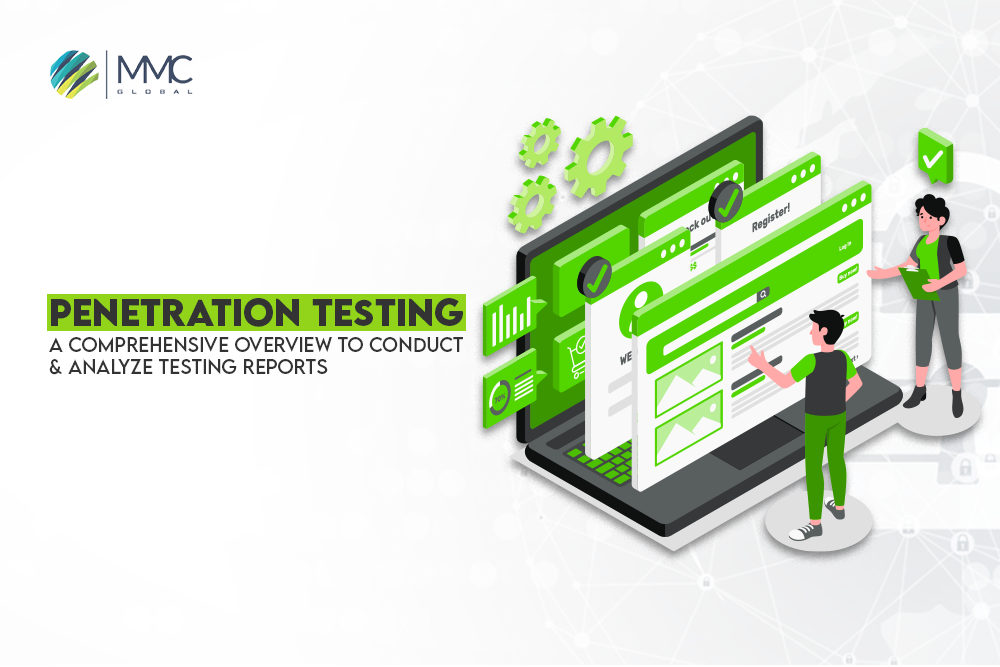Penetration Testing: A Comprehensive Overview To Conduct & Analyze Testing Reports


Penetration testing is a form of testing that is particularly conducted for security checks into the system and networking, allowing organizations to understand and detect weak endpoints. It is a proactive approach to strengthen cybersecurity, where testers allow you to break into your systems to find vulnerabilities. These tests are also called ethical hacking or white-hat hacking.
It is a step-by-step process of conducting penetration testing containing dynamic techniques and a comprehensive report explaining the details of detected susceptibles and defensive remediations. To perform penetration testing, it is a must to hire a professional penetration testing team that knows all technical aspects.
MMC Global has offered penetration testing services to multiple organizations for decades, and our implemented remediations help organizations improve security barriers and avoid any inconvenience. Our team reviews every touch, analyzes the gap, tests as a hacker, and then creates a report of all shortcomings in technical and non-technical summaries.
To understand the critical components of penetration testing, we create a well-versed summary so that every board member, senior management, and IT department understands the essential turning points. This blog will cover understanding the scope and implementing remediation of penetration testing reports.
The Scope And Methodology of Penetration Testing reports
Creating a penetration testing report is like adding all findings in one frame with detailed descriptions so that every concerned person gets optimal knowledge about problems. The aim of conducting testing is to identify gaps and detect problems to get the best solution before the problem gets worse. The quicker we find the potential issues, the quicker we can extract the solutions.
At MMC Global, we create well-defined penetration testing reports that include clear test cases and findings for technical and non-technical staff without using technical jargon. Moreover, we also added a technical section which contains technical information for IT and administrations to provide recommended changes if applicable.
Additionally, you can not just start acting on findings or implementing remediations; thorough knowledge of methodologies and long-term scope should be the roadmap for further action. Here are our penetration testing reports, which provide a walkthrough for implementing remediations.
Executive Summary
The first page outlines the major components, which summarises the report. The ideal executive summary emphasizes sharing lots of information in a single-page rundown. This summary provides a clear and concise plot of overall penetration testing that is easily digestible to all non-techie and techie team members, like:
- Share test cases and findings.
- Provide a brief overview of expected vulnerabilities.
- Validate the security measures and identify weak security ports that fail to stop cyberattacks.
- Give recommendations to resolve the issues.
Scope Of Work
The scope of a penetration test defines the boundaries of what the test will cover. This is crucial because it sets expectations and ensures that both the testers and the organization are aligned on the objectives of the test. Here’s what to look for:
Defined Assets
The scope will typically list the assets that were tested. This includes:
- Networks: Internal and external networks, cloud infrastructure.
- Applications: Web applications, mobile apps, APIs.
- Systems: Servers, workstations, IoT devices.
- Data: Specific datasets or databases, if applicable.
Understanding which assets is essential for evaluating whether the pentest comprehensively covered your critical infrastructure.
Types of Tests Conducted
The scope should also outline the types of tests performed. Common types include:
- External Penetration Testing: Simulates attacks from outside your organization to identify vulnerabilities exposed to the internet.
- Internal penetration testing focuses on threats from within your organization, such as insider threats.
- Web Application Penetration Testing: This type of testing examines web applications for vulnerabilities such as SQL injection, cross-site scripting (XSS), and more.
- Social Engineering Testing: Assesses the human element, such as phishing attacks and manipulation of employees.
Each type of test targets different areas of your security infrastructure, so understanding what was covered will help you assess the comprehensiveness of the penetration test.
Time Frame
The scope will also include the time frame for the test. Cybersecurity threats evolve rapidly, so knowing when the test was performed can help you determine if there may be newer vulnerabilities that weren’t accounted for.
Methodology of Penetration Testing
The methodology section of the report outlines how the penetration testing was conducted. This is key to understanding the reliability and thoroughness of the findings. Here’s what you should expect:
Testing Phases
Penetration testing generally follows a structured methodology, broken down into phases:
- Reconnaissance: Gathering information about the target systems to understand the environment.
- Scanning: Identifying live hosts, open ports, and services running on the target systems.
- Exploitation: Attempting to exploit vulnerabilities found during the scanning phase to gain unauthorized access or escalate privileges.
- Post-Exploitation: Assessing the exploitation’s impact and determining what actions a malicious actor could take.
- Reporting: Documenting the findings, including vulnerabilities discovered, the methods used to exploit them, and recommendations for mitigation.
Understanding these phases helps you see how the testers approached the task and where they found potential security gaps.
Tools and Techniques
The methodology section should also list the tools and techniques used during the penetration testing. Standard tools might include:
- Nmap: For network discovery and security auditing.
- Metasploit: For developing and executing exploit code.
- Burp Suite: For web application security testing.
- Custom Scripts: Developed by testers for specific scenarios.
The testing team’s thoroughness and expertise are reflected in the use of well-known and trusted tools and custom techniques.
Risk Ratings and Classification
Vulnerabilities discovered during the test are classified based on risk level—critical, high, medium, or low. Understanding the criteria used for these classifications is essential. For example:
- Critical: Vulnerabilities that can lead to complete system compromise.
- High: Issues that can cause significant damage but might require specific conditions.
- Medium: Vulnerabilities that could be exploited under specific conditions or with other vulnerabilities.
- Low: Minor issues that are unlikely to be exploited but should still be addressed.
The methodology should explain how these ratings were determined, enabling you to prioritize remediation efforts effectively.
Conclusion and Next Steps
Understanding the scope and methodology of your penetration testing report is crucial for making informed decisions about your cybersecurity strategy. By clearly defining what was tested, how it was tested, and what the findings mean, you can better assess your organization’s risk and take targeted actions to improve your security posture.
After reviewing the report, consider the following next steps:
- Mitigation: Address the identified vulnerabilities based on their risk ratings.
- Re-testing: Once issues are fixed, conduct a re-test to ensure vulnerabilities have been effectively mitigated.
- Continuous Monitoring: Implement ongoing and periodic testing to adapt to new threats.
Penetration testing is not a one-time event but a critical part of a continuous security strategy. Understanding your penetration testing report empowers your organization to stay ahead of potential threats and protect your valuable assets.



